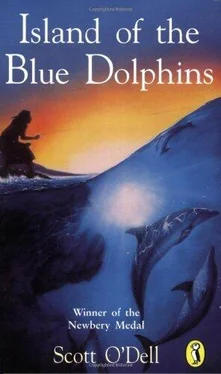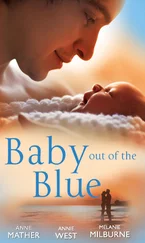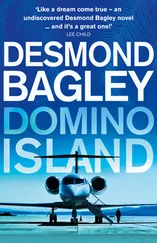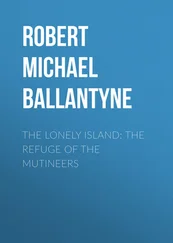I crawled under the fence and stood facing them. The man in the grey robe had a string of beads around his neck and at the end of it was an ornament of polished wood. He raised his hand and made a motion towards me which was the shape of the ornament he wore. Then one of the two men who stood behind him spoke to me. His words made the strangest sounds I have ever heard. At first I wanted to laugh, but I bit my tongue.
I shook my head and smiled at him. He spoke again, slowly this time, and though his words sounded the same as before and meant nothing to me, they now seemed sweet. They were the sound of a human voice. There is no sound like this in all the world.
The man lifted his hand and pointed towards the cove and made a picture in the air of what could have been a ship.
To this I nodded and myself pointed to the three baskets I had placed by the fire, making a gesture of taking them with me to the ship. Also the cage in which I had put two young birds.
There were many gestures before we left, though the two men spoke among themselves. They liked my necklace, the cape, and the cormorant skirt that shone in the sun. But when we got to the beach, where their camp was, the first thing the man who spoke the most did was to tell the other men to make me a dress.
I knew this was what he said because one of them stood in front of me and held up a string from my neck to my feet and across my shoulders.
The dress was blue. It was made of two trousers, just like those the white men were wearing. The trousers were cut up into pieces and then one of the men sat down on a rock and put them together again with white string. He had a long nose, which looked like the needle he used. He sat all afternoon on the rock and the needle went back and forth, in and out, flashing in the sun.
From time to time he would hold up the dress and nod his head as if he were pleased. I nodded as if I were pleased, too, but I was not. I wanted to wear my cormorant skirt and my otter cape, which were much more beautiful than the thing he was making.
The dress reached from my throat to my feet and I did not like it, either the colour of it or the way it scratched. It was also hot. But I smiled and put my cormorant skirt away in one of the baskets to wear when I got across the sea, sometime when the men were not around.
The ship stayed in Coral Cove nine days. It had come for otter, but the otter had gone. Some must have been left, after all, who remembered the Aleuts, for on that morning there were none to be seen.
I knew where they had gone. They had gone to Tall Rock, but when the men showed me the weapons they had brought to kill the otter, I shook my head and acted as though I did not understand. They pointed to my otter cape, but I still shook my head.
I asked them then about the ship that had taken my people away many years before, making the signs of the ship and pointing to the east, but they did not understand. Not until I came to Mission Santa Barbara and met Father Gonzales did I learn from him that this ship had sunk in a great storm soon after it reached his country and that on the whole ocean thereabouts there was no other. For this reason the white men had not come back for me.
On the tenth day we sailed. It was a morning of blue skies and no wind. We went straight towards the sun.
For a long time I stood and looked back at the Island of the Blue Dolphins. The last thing I saw of it was the high headland. I thought of Rontu lying there beneath the stones of many colours, and of Won-a-nee, wherever she was, and the little red fox that would scratch in vain at my fence, and my canoe hidden in the cave, and of all the happy days.
Dolphins rose out of the sea and swam before the ship. They swam for many leagues in the morning through the bright water, weaving their foamy patterns. The little birds were chirping in their cage and Rontu-Aru sat beside me.
The island called in this book the Island of the Blue Dolphins was first settled by Indians in about 2000 B.C., but it was not discovered by white men until 1602.
In that year the Spanish explorer Sebastián Viz-caíno set out from Mexico in search of a port where treasure galleons from the Philippines could find shelter in case of distress. Sailing north along the California coast, he sighted the island, sent a small boat ashore and named it La Isla de San Nicolas, in honour of the patron saint of sailors, travellers, and merchants.
As the centuries passed, California changed from Spanish to Mexican hands, the Americans arrived, but only occasional hunters visited the island. Its Indian inhabitants remained in isolation.
The girl Robinson Crusoe whose story I have attempted to re-create actually lived alone upon this island from 1835 to 1853, and is known to history as The Lost Woman of San Nicolas.
The facts about her are few. From the reports of Captain Hubbard, whose schooner carried away the Indians of Ghalas-at, we know that the girl did jump into the sea, despite efforts to restrain her. From records left by Captain Nidever we know that he found her eighteen years later, alone with a dog in a crude house on the headland, dressed in a skirt of cormorant feathers. Father Gonzales of Santa Barbara Mission, who befriended her after her rescue, learned that her brother had been killed by wild dogs. He learned little else, for she spoke to him only in signs; neither he nor the many Indians at the mission could understand her strange language. The Indians of Ghalas-at had long since disappeared.
The Lost Woman of San Nicolas is buried on a hill near the Santa Barbara Mission. Her skirt of green cormorant feathers was sent to Rome.
Outermost of the eight Channel Islands, San Nicolas is about seventy-five miles south-west of Los Angeles. For years historians thought that it had been settled some six centuries ago, but recent carbon-14 tests of excavations on the island show that Indians came here from the north long before the Christian era. Their images of the creatures of the land, sea, and air, similar to those found on the shores of Alaska and carved with extraordinary skill, may be seen at the South-west Museum in Los Angeles
The future of San Nicolas is not clear. It is now a secret base of the United States Navy, but scientists predict that because of the pounding waves and furious winds it will one day be swept back into the sea.
In the writing of the Island of the Blue Dolphins, I am deeply indebted to Maude and Delos Lovelace, to Bernice Eastman Johnson of the South-west Museum, and to Fletcher Carr, formerly curator of the San Diego Museum of Man.











